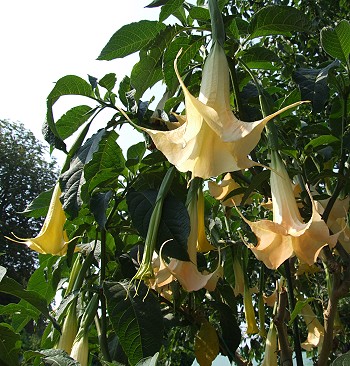
|
|
Angel's Trumpets
- Brugmansia aurea
|
Angel's Trumpets -
Brugmansia spp.
Brugmansia is a genus of six species of flowering plants in the family
Solanaceae, native to subtropical regions of South America, along the Andes from Colombia to northern
Chile, and also in southeastern Brazil. They are known as Angel's Trumpets, sharing that name with the closely related genus
Datura because of their flowers have the shape of trumpets. Brugmansia differs from Datura in being perennial and woody
(Datura species are herbaceous), and in having pendulous (not erect) flowers. The principal distinction between the two kinds comes owing to the fact that the flowers of datura are set
up, whereas those of the brugmansia are falling, with the manner of small bells.
Moreover, the brugmansias are shrubs, while the majority of the daturae are herbaceous
plants. The two plants are however very close, and they have the same toxic characteristics,
one notes in particular the presence of Scopolamine in their sap.
Brugmansia are large shrubs or small trees, reaching heights of 3–11 m, with
tan, slightly rough bark. The leaves are alternate, generally large, 10–30 cm long and 4–18 cm
broad, with an entire or coarsely toothed margin, and are covered with fine
hairs. The name Angel's Trumpet refers to the large, very dramatic, pendulous
trumpet-shaped flowers, 14–50 cm to 20 inches long and 10–35 cm across at the wide
end. They are white, yellow, pink, orange or red, and have a delicate, attractive scent with
light, lemony overtones, most noticeable in early evening.
The plant was discovered by Alexander von Humboldt and Aime Bonpland during their exploration of South America at the beginning of the 19th
century. It owes its name with Sebald Justinus Brugmans (1763-1819), professor of natural history at the university of
Leiden. It would be originating in the the Andes, but currently pushes in a spontaneous state in the the Caribbean and in
Oceania. To the the United States and in Europe, it was acclimatized and marks a clear preference for the climates and the grounds at the same time wet and
hot. Many botanical varieties were created for the pleasure gardens. The flowers are generally white or yellow ( B. candida ), but of the species or the varieties with more coloured colors also
exist, just like species with double, or triple flowers. They reach easily from twenty to thirty centimetres in length and
diameter. Their perfume, which appears only in evening, is very intense and attracts the night insects
preferably.
As with Datura, all parts of Brugmansia are highly
toxic. The plants are sometimes ingested for recreational or shamanic intoxication as the plant contains the tropane alkaloids scopolamine and
atropine; however because the potency of the toxic compounds in the plant is
variable, the degree of intoxication is unpredictable and can be fatal.
Ritualized Brugmansia consumption is an important aspect of the shamanic complexes noted among many Indigenous peoples of western
Amazonia, such as the Jivaroan speaking peoples. Likewise, it is a central component in the cosmology and shamanic practices of the Urarina peoples of
Loreto, Peru.
South American shaman warn against their use by anyone not familiar with the
plant.
Brugmansia use is restricted to all, except experienced shaman. Large doses can cause delirium and hallucinations that last for
days, after-effects can last for weeks.
Among the pre-Conquest Chibcas of Colombia a concoction of
Brugmansia, tobacco and maize beer was given to slaves and wives of dead kings in order to put them in a deep narcotic state so that they could be buried alive with their masters and
husbands.
An account from 1589 details just such an occurrence: a dead chief was accompanied to the tomb by his women and
slaves, who were buried in different layers of earth ... of which none was without
gold.
And so that the women and poor slaves should not fear their death before they saw the awful
tomb, the nobles gave them things to drink of inebriating Tobacco and other leaves of the tree we call
Borrachero, all mixed in their usual drink, so that of their senses none is left to foresee the harm soon to befall
them.
Source:
http://en.wikipedia.org/wiki/Floripondio
http://www.a1b2c3.com/drugs/var006.htm
http://www.speedylook.com/Brugmansia.html
